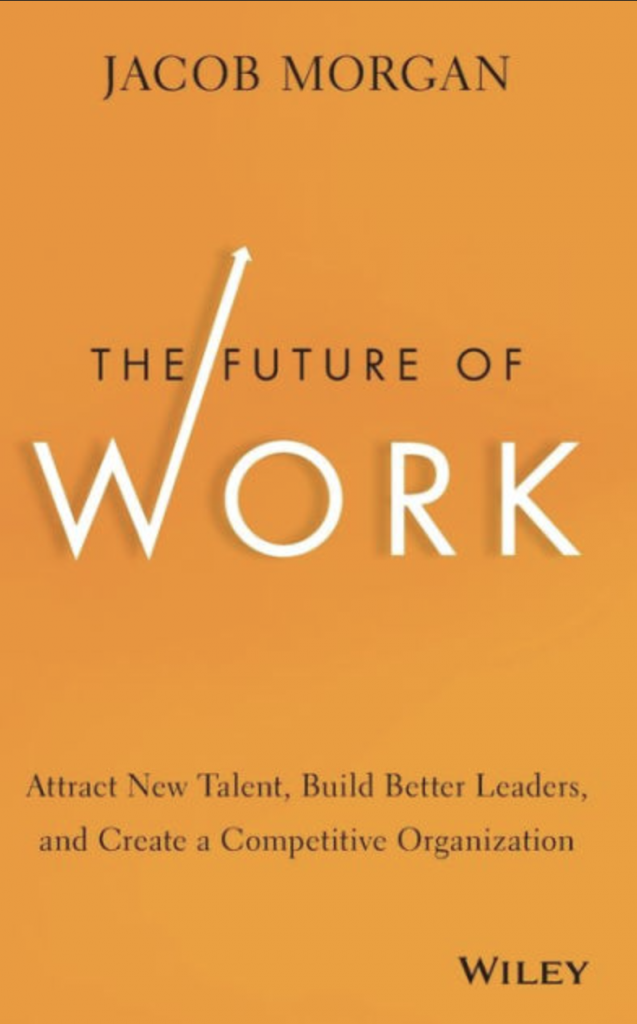Key Quote:
Jacob Morgan’s The Future of Work describes how factors like millennials, technological advancements, and a truly global economy have and will shape the way we work. As Morgan stresses time and time again, these changes are occurring in real time and organizations must either adapt now or end up as part of Christiansen’s 75%.
Key Points and Concepts
Five Trends Shaping the World of Work
1. New behaviors: In the past, there was a clear distinction between our public and private lives. Today, the two are blending thanks to Google searches, Facebook, and the ubiquitous “selfie.” Our personal lives are broadcast around the globe, and as we use more and more technological innovations, it appears this trend will only pick up speed.
2. Technology: One of the largest changes seen in the past decade is the rapid increase in technological capabilities. The introduction of tools such as cloud computing and storage, collaboration platforms, big data, and the prospect of the “internet of things” has dramatically altered the way we work with each other.
3. Millennials: “By 2025 it’s estimated that millennials will be around 70% to 75% of the U.S. workforce” (p. 13). For years authors have written about the rise of millennials, but within the next few years it will be happening. This is a generation that has grown up with the internet, cell phones, and a variety of other technological advances, and brings a fresh perspective to the workplace.
4. Mobility: 91% of all people on earth own a mobile phone, with over 22% of people owning a smartphone. Gone are the days when coming into the office from nine to five is the norm. Now, people can work whenever, wherever, and however they want.
5. Globalization: It’s having a tremendous impact across geographies and industries. Major automotive companies have parts built all over the world and assemble them in Detroit. Companies have customer service units based all over the world to provide around-the-clock support. With technological advancements made in the last 50 years, time and space aren’t the obstacles they once were.
Seven Principles of the Future Employee
1. Has a flexible work environment: Employees will be able to work anytime, anywhere, and the emphasis will be on outputs, not inputs. In the past, a good worker was someone who showed up early and left late. The future worker will be judged instead on what they produce, regardless of how many hours they put in to complete it.
2. Can customize own work: Internal social networks and collaboration platforms will give employees a voice to share their ideas with the rest of the organization, allowing them to work on projects outside their “specialty.” Employees will also be able to determine how much they want to travel, whether they want to work in an office or at home, or a variety of other factors so the best person is working on the right projects.
3. Shares information: Many departments within organizations silo information so that they can take credit for the newest, greatest breakthrough. The 9/11 Commission cited the lack of a central database as one of the main culprits for the terrorist attacks on September 11th not being detected sooner. Free flowing information promotes innovation and breakthroughs, and it will be a key tool in the future employee’s toolkit.
4. Uses new ways to communicate and collaborate: Future employees will utilize video conferencing, social media, collaborative platforms, and other tools rather than sending hundreds of emails a day.
5. Can become a leader: “Today we are at a unique point in the world of work where leadership is no longer something reserved for the appointed few who sit at the top of the corporate pyramid. Leaders are no longer appointed—they are created by building a following, and today, any employee has the ability to do this” (p. 51).
6. Shift from being knowledge worker to learning worker: Those at the top of the organizational food chain used to be the ones that had amassed the most knowledge and information over years of firsthand experience. Today, seemingly endless amounts of information are at our fingertips. The future heads of organizations will be the ones that can learn and adapt the fastest.
7. Learn and teach at-will: College, training seminars, and workshops used to be the way employees learned new skills. Now, with resources like the Khan Academy and others, employees have the ability to learn new skills at their leisure at little to no charge.
The Freelancer Economy
• A central component of the future workforce will be the freelance economy. “According to a report by Intuit…by around 2020 around 40% of the U.S. workforce will be working as freelancers, temp workers, or contractors (some predict this number to get as high as 50%)” (p. 69).
• With the ability to determine how much and how often they work, along with their own wages, freelancers have unprecedented freedom, while organizations are spared the costs of having a full-time employee on the payroll.
Ten Principles of the Future Manager
1. Must be a leader: “If you had managers who were consistently improving the bottom-line quarter after quarter, but employees hated working for them would they be considered good managers? Similarly, if you worked for leaders who did an amazing job of engaging and inspiring employees but who failed to deliver any tangible results would they be good leaders? The answer to both is no. Remember that any employee has the potential to become a leader, but a manager who is responsible for other people must be a leader” (p. 93).
2. Follow from the front: Managers’ goal should be to remove roadblocks from their employees’ paths to help them succeed. “The managers are holding up the pyramid, not standing on top of it” (p. 95).
3. Understand technology: While managers will not have to be experts in every new piece of technology, they will be required to understand how it can benefit their teams and the larger organization.
4. Lead by example: Executive sponsorship is always a key factor in change adoption. When leaders actively participate in and adopt new initiatives, technology platforms, or projects, the chance of it succeeding increases immensely.
5. Embrace vulnerability: Business is built on relationships. When people worked in factories churning out manufactured goods, the cold, robotic managerial style worked. Those days are gone. If managers want to generate great results, they need to connect with their employees
and admit that they don’t always have all the answers.
6. Believe in sharing and collective intelligence: The classic image of innovation is the R&D department buried 10 stories underground, working around the clock on classified material. The future manager will instead embrace idea sharing and fresh perspectives to increase
innovation and creativity.
7. Challenge convention and be a fire starter: In chess, players often start with prepared opening moves, but after the first few, players are on their own to determine how the rest of the game will go. The same applies for managers. While there may be some initial guidelines managers can rely on, in order to get the most out of their teams, they need to think in new ways and not be afraid to experiment.
8. Practice real-time recognition and feedback: Most organizations rely on an annual or semi-annual review process to provide feedback and recognition to their employees. Managers of the future will employ regular check-ins to provide their employees with praise and course correct when appropriate.
9. Be conscious of personal boundaries: Two of the biggest boundaries between managers and employees are time and space. Managers must remember that employees have lives outside of work and must respect that. Also, managers need to avoid stepping over the friend / coworker boundary. One study found that 47% of employees are uncomfortable with being Facebook friends with their boss, while 40% of managers are uncomfortable with being Facebook friends with employees (p. 114).
10. Adapt to the future employee: Instead of forcing employees into managers’ preconceived notions, managers must act as enablers for the employees, and put them in the best position to succeed.
Morgan, J. (2014) The Future of Work: Attract New Talent, Build Better Leaders, and Create a Competitive Organization. Hoboken, NJ: John Wiley & Sons, Inc.

One of the largest changes seen in the past decade is the rapid increase in technological capabilities. The introduction of tools such as cloud computing and storage, collaboration platforms, big data, and the prospect of the “internet of things” has dramatically altered the way we work with each other.
A central component of the future workforce will be the freelance economy. “According to a report by Intuit…by around2020 around 40% of the U.S. workforce will be working as freelancers, temp workers, or contractors (some predict this number to get as high as 50%).”
Instead of forcing employees into managers’ preconceived notions, managers must act as enablers for the employees, and put them in the best position to succeed.
